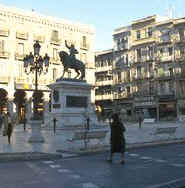COMMERCE AND INDUSTRY
We can be sweet and romantic like everyone else, but this is a land of business-oriented people. We do not worship gold, as some people seem to believe. However, we speak our minds frankly and clearly and we mean business.
Over here you will find shops and firms of every description, from the local grocer´s to huge multinational companies. Whatever you need, we´ve got it. And reasonably priced too!
Cars are made in Barcelona and some of its neighbouring towns.
You'll see toys in the southern territories. And Tarragona is the place for chemical products.
Catalans also produce paper, cement and other building materials.
Sabadell and Terrassa are two big industrial towns not far from Barcelona. Reus (further south, near Tarragona) is a well-known cultural and commercial centre. The cities of Girona and Lleida are well worth a visit, too.


La Plaça Prim, Reus.
Industry in Reus. Not my hometown, but almost so...
The Catalan industrial revolution of the 18th and 19th centuries manifested itself in Reus
in the form of large-scale development of the textile industry, mainly in silk and cotton.
Together with textiles, the processing of agricultural produce became the other great
pillar of the area's economy.
Throughout the first half of the 20th century this specialisation was sustained, with the
addition of activities connected with metalworking which gave Reus and the Baix Camp a
more diversified industrial structure.
The present industrial structure is particularly solid, since while it does not include
sectors with great potential to pull it forward, the presence of sectors with weak demand
is, apart from that of textiles, very small.
On the level of business structure Reus has a large number of small and medium-sized
companies, each with relatively small workforces and generally locally-run.
On the other hand there are larger-scale companies run from outside the area. A large
proportion of these are production plants set up because of the advantages of the
location. Others are companies of local origin but with foreign participation or joint
ventures between local entrepreneurs and outside companies.

The development of the petrochemical industry around Tarragona has allowed numerous small
and medium-sized companies of local origin linked to this industry to spring up.
The textile industry developed on the basis of outside initiatives, mostly from the
Barcelona area, and nowadays one can find relatively large outside companies but which are
long-established in the area. The various crises of the sector have, however, reduced this
presence, while leading to the development of interesting local initiatives.
The paper, graphic arts, wood and construction materials sectors are formed by small and
medium-sized, locally-based companies, which basically supply the local market.
The agricultural sector has traditionally been one of the most representative and dynamic
within the productive structure of the Baix Camp. Based mainly in Reus, it currently
accounts for 20% of the industrial workforce, but its importance is greater than this,
because of the effects generated by the inter-relationship between primary and commercial
sectors in the area.
Reus has traditionally been the centre through which the agricultural output of Tarragona
province and other areas has been channelled. This has generated an industry processing
raw materials and distributing the product, of which the most representative parts are
those connected with nuts and oil.
Nut processing
Reus has traditionally been the centre for nut distribution, with a scope far larger than
the local. The existence of an internationally-recognised commodity exchange has
benefitted this sector, so that the area accounts for 90% of Spanish hazelnut production
and 65% of almonds.
Oil processing
Linked to olive-growing and the conversion of the produce into olive oil, the trade in oil
has spread throughout the area.